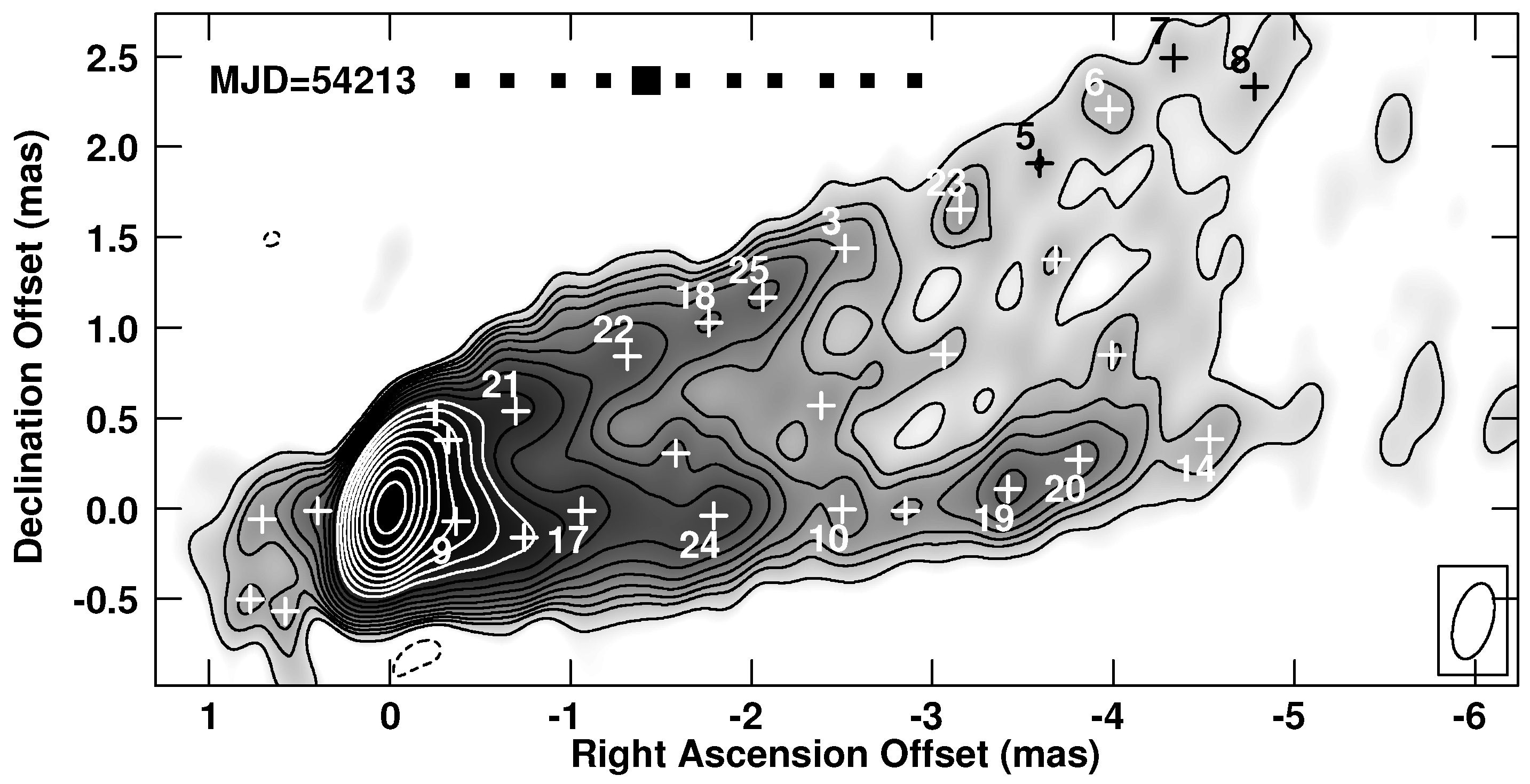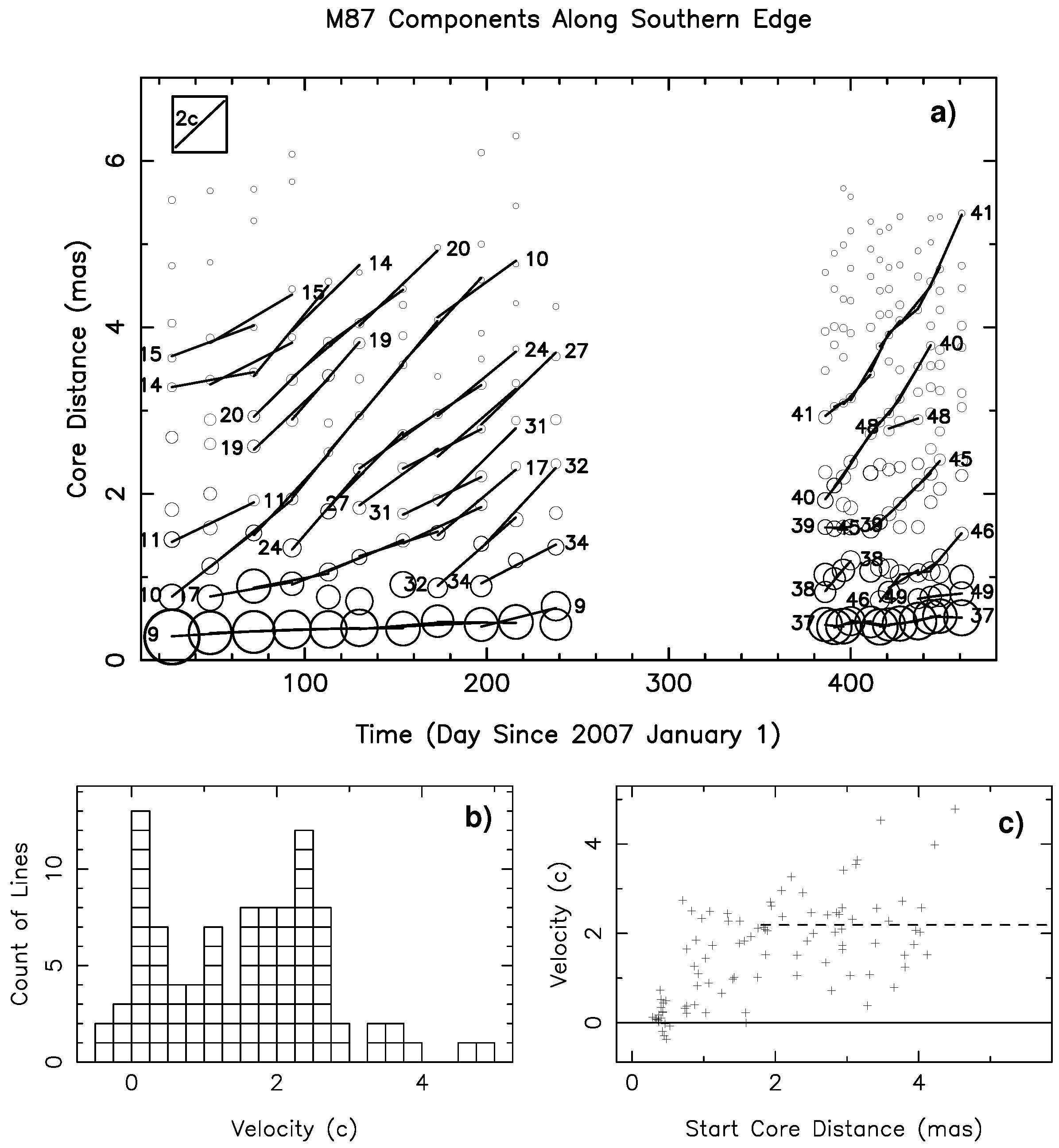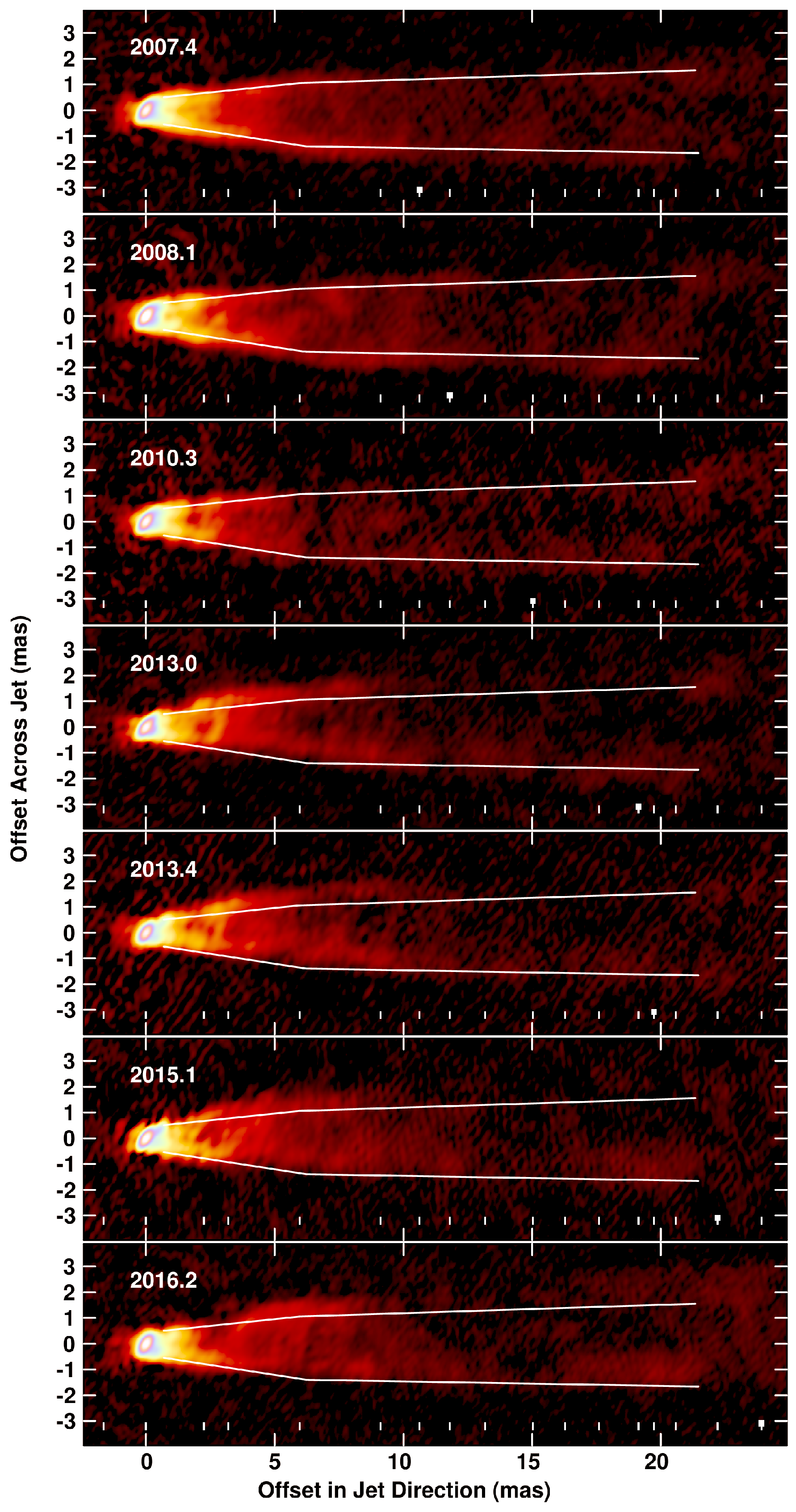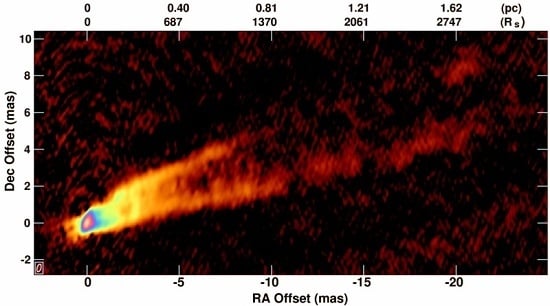Observations of the Structure and Dynamics of the Inner M87 Jet
Abstract
:1. Introduction
2. The Observations
3. Jet Shape
4. Jet Speed
5. Long Term Variations
6. Summary
- The jet has an edge-brightened structure with a wide opening angle at the base and a parabolic shape over the region of these observations.
- The velocity structure is complex, with co-existing slow moving features (∼0.4c) and superluminal features (∼2.3c). These are seen both using traditional methods of following emission peaks and through the WISE analysis.
- The faster moving system accelerates to near its full speed over the first ∼2 mas, which is ∼0.16 pc (∼274 R) in projection or ∼0.52 pc (∼890 R) along the jet for a jet angle to the line-of-sight of .
- There is a counterjet that mirrors the structure of the main jet, but drops rapidly in brightness as would be expected in the acceleration region.
- An angle to the line-of-sight of is determined by 3 methods based on the WISE results.
- There is a difference in the measured speed of the northern and southern rims of the jet. A possible implication is rotation of the jet with a rate of about s. That, in turn, suggests the jet is launched from the disk at a radius of ∼5 R.
- Roughly annual observations over 17 years show that there are side-to-side motions of the entire jet with a characteristic time scale of about 9 years.
Acknowledgments
Author Contributions
Conflicts of Interest
References
- Mei, S.; Blakeslee, H.P.; Côté, P.; Tonry, J.L.; West, M.J.; Ferrarese, L.; Jordán, A.; Peng, E.W.; Anthony, A.; Merritt, D. The ACS Virgo Cluster Survey. XIII. SBF Distance Catalog and the Three-Dimensional Structure of the Virgo Cluster. Astrophys. J. 2007, 655, 144. [Google Scholar] [CrossRef]
- Walsh, J.L.; Barth, A.J.; Ho, L.C.; Sarzi, M. The M87 Black Hole Mass from Gas-dynamical Models of Space Telescope Imaging Spectrograph Observations. Astrophys. J. 2013, 720, 86. [Google Scholar] [CrossRef]
- Gebhardt, K.; Adams, J.; Richstone, D.; Lauer, T.R.; Faber, S.M.; Gultenkin, K.; Murpy, J.; Tremaine, S. The Black Hole Mass of M87 from Gemini/NIFS Adaptive Optics Observations. Astrophys. J. 2011, 729, 119. [Google Scholar] [CrossRef]
- Napier, P.J.; Bagri, D.S.; Clark, B.G.; Rogers, A.E.E.; Romney, J.D.; Thompson, A.R.; Walker, R.C. The Very Long Baseline Array. Proc. IEEE 1993, 82, 658–672. [Google Scholar] [CrossRef]
- Junor, W.; Biretta, J.A.; Livio, M. Formation of the radio jet in M87 at 100 Schwarzschild radii from the central black hole. Nature 1999, 401, 891–892. [Google Scholar]
- Ly, C.; Walker, R.C.; Wrobel, J.M. An Attempt to Probe the Radio Jet Collimation Regions in NGC 4278, NGC 4374 (M84), and NGC 6166. Astrophys. J. 2004, 127, 119–124. [Google Scholar] [CrossRef]
- Ly, C.; Walker, R.C.; Junor, W. High-frequency VLBI Imaging of the Jet Base of M87. Astrophys. J. 2007, 660, 200–205. [Google Scholar] [CrossRef]
- Walker, R.C.; Ly, C.; Junor, W.; Hardee, P.E. A VLBA Movie of the Jet Launch Region in M87. J. Phys. Conf. 2008, 131, 012053. [Google Scholar] [CrossRef]
- Kovalev, Y.Y.; Lister, M.L.; Cohen, D.C.; Kellermann, K.I. The Inner Jet of the Radio Galaxy M87. Astrophys. J. 2007, 668, L27. [Google Scholar] [CrossRef]
- Hada, K.; Kino, M.; Doi, A.; Nagai, H.; Honma, M.; Akiyama, K.; Tazaki, F.; Lico, R.; Giroletti, M.; Giovannini, G.; et al. High-Sensitivity 86GHz (3.5mm) VLBI Observations of M87: Deep Imaging of the Jet Base at a 10 Schwarzschild-Radius Resolution. Astrophys. J. 2016, 817, 131. [Google Scholar] [CrossRef]
- Asada, K.; Nakamura, M. The Structure of the M87 Jet: A Transition from Parabolic to Conical Streamlines. Astrophys. J. 2012, 745, L28. [Google Scholar] [CrossRef]
- Marscher, A.P.; Jorstad, S.G.; D’Arcangelo, F.D.; Smith, P.S.; Williams, G.G.; Larionov, V.M.; Oh, H.; Olmstead, A.R.; Aller, M.F.; Aller, H.D.; et al. The inner jet of an active galactic nucleus as revealed by a radio-to-γ-ray outburst. Nature 2008, 452, 966–969. [Google Scholar] [CrossRef] [PubMed]
- Hada, K.; Doi, A.; Kino, M.; Nagai, H.; Hagiwara, Y.; Kawaguchi, N. An origen of the radio Jet in M87 at the location of the central black hole. Nature 2011, 477, 185–187. [Google Scholar] [CrossRef] [PubMed]
- Asada, K.; Nakamura, M.; Doi, A.; Nagai, H.; Inoue, M. Discovery of Sub- to Superluminal Motions in the M87 Jet: An Implication of Accleeration from Sub-relativistic to Relativistic Speeds. Astrophys. J. 2014, 781, L2. [Google Scholar] [CrossRef]
- Biretta, J.A.; Sparks, W.B.; Macchetto, F. Hubble Space Telescope Observations of Superluminal Motion in the M87 Jet. Astrophys. J. 1999, 520, 621. [Google Scholar] [CrossRef]
- Cheung, C.C.; Harris, D.E.; Stawarz, Ł. Superluminal Radio Features in the M87 Jet and the Site of Flaring TeV Gamma-Ray Emission. Astrophys. J. 2007, 663, L65. [Google Scholar] [CrossRef]
- Walker, R.C.; Hardee, P.E.; Davies, F.; Ly, C.; Junor, W. Observations of the Structure and Dynamics of the Inner M87 Jet. 2016; in preparation. [Google Scholar]
- Mertens, F.; Lobanov, A.P.; Walker, R.C.; Hardee, P.E. Kinematics of the jet in M87 on scales of 100–1000 Schwarzschild radii. Astron. Astrophys. 2016, in press. [Google Scholar] [CrossRef]
- Acciari, V.A.; The VERITAS Collaboration; the VLBA 43 GHz M87 Monitoring Team; the H.E.S.S. Collaboration; the MAGIC Collaboration. Radio Imaging of the Very-High-Energy Gamma-Ray Emission Region in the Central Engine of a Radio Galaxy. Sci. Mag. 2009, 325, 444. [Google Scholar]
- Hada, K.; Giroletti, M.; Kino, M.; Giovannini, G.; D’Ammando, F.; Cheung, C.C.; Beilicke, M.; Nagai, H.; Doi, A.; Akiyama, K. A Strong Radio Brightening at the Jet Base of M87 During the Elevated Very High Energy Gamma-Ray State in 2012. Astrophys. J. 2014, 788, 165. [Google Scholar] [CrossRef]
- Mertens, F.; Lobanov, A. Wavelet-based decomposition and analysis of structural patterns in astronomical images. Astron. Astrophys. 2015, 574, A67. [Google Scholar] [CrossRef]
- Lobanov, A. What’s There in Jets: Shocks and Threads or Cords and Frets? Galaxies 2016. in preparation. [Google Scholar]
- Tchekovskoy, A.; Narayan, R.; McKinney, J.C. Efficient generation of jets from magnetically arrested accretion on a rapidly spinning black hole. Mon. Not. R. Astron. Soc. 2011, 418, L79. [Google Scholar] [CrossRef]
- Deller, A.; Brisken, W.F.; Phillips, C.J.; Morgan, J.; Alef, W.; Cappallo, R.; Middelberg, E.; Romney, J.; Rottmann, H.; Tingay, S.J. DiFX-2: A More Flexible, Efficient, Robust, and Powerful Software Correlator. Publ. Astron. Soc. Pac. 2011, 123, 275. [Google Scholar] [CrossRef]







© 2016 by the authors; licensee MDPI, Basel, Switzerland. This article is an open access article distributed under the terms and conditions of the Creative Commons Attribution (CC-BY) license (http://creativecommons.org/licenses/by/4.0/).
Share and Cite
Walker, R.C.; Hardee, P.E.; Davies, F.; Ly, C.; Junor, W.; Mertens, F.; Lobanov, A. Observations of the Structure and Dynamics of the Inner M87 Jet. Galaxies 2016, 4, 46. https://doi.org/10.3390/galaxies4040046
Walker RC, Hardee PE, Davies F, Ly C, Junor W, Mertens F, Lobanov A. Observations of the Structure and Dynamics of the Inner M87 Jet. Galaxies. 2016; 4(4):46. https://doi.org/10.3390/galaxies4040046
Chicago/Turabian StyleWalker, R. Craig, Philip E. Hardee, Fred Davies, Chun Ly, William Junor, Florent Mertens, and Andrei Lobanov. 2016. "Observations of the Structure and Dynamics of the Inner M87 Jet" Galaxies 4, no. 4: 46. https://doi.org/10.3390/galaxies4040046





